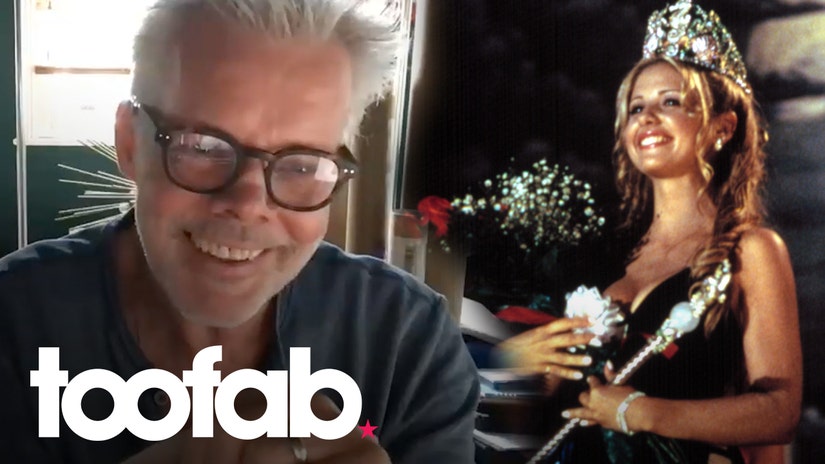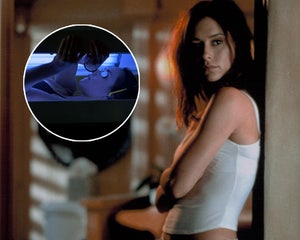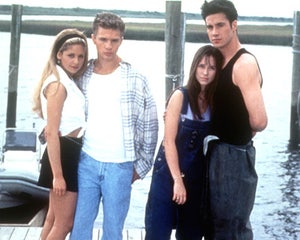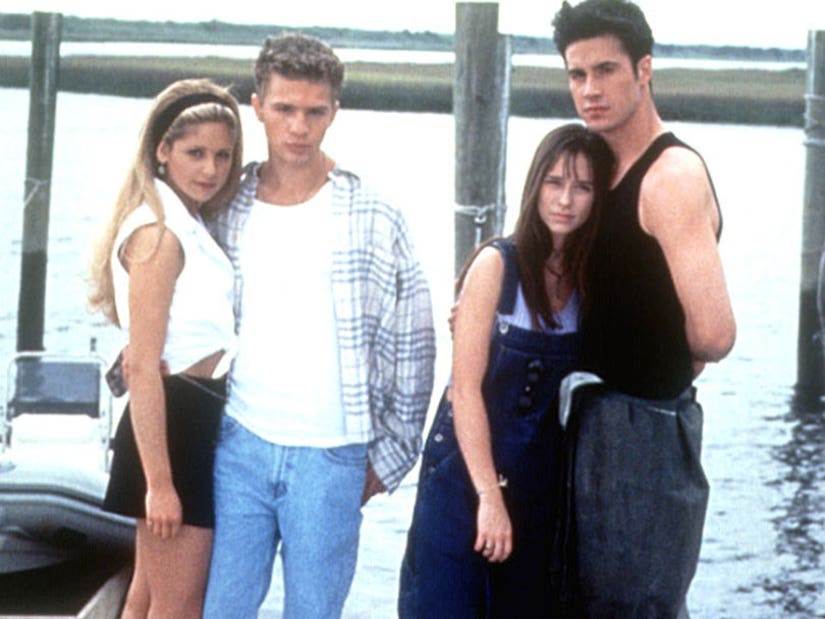The film's director reveals two Oscar-winners were up for Gellar's role, which cut moments wound up in Scream movies and reacts to some 25-year-old criticism.
Sarah Michelle Gellar’s Helen Shivers may have gotten the hook in “I Know What You Did Last Summer,” but the epic chase scene leading up to the beauty queen’s death lives on as one of the best in horror history.
The actress solidified her place in the Scream Queen Hall of Fame in 1997 thanks to killer set pieces in both “IKWYDLS” and “Scream 2,” both of which celebrate their 25th anniversaries this year. To mark the former’s silver anniversary, TooFab caught up with the film’s director, Jim Gillespie, who walked us through the relentless chase sequence and revealed some behind-the-scenes intel from the set.
Before getting into the intricacies of the scene itself, we need to take a minute to first praise Gellar’s performance in this movie. The teen slasher was one of her first big film roles, which hit theaters right after the second season of “Buffy the Vampire Slayer” kicked off on The WB. The first season aired earlier that year — and, per Gillespie, she was filming the pilot when she auditioned for the movie. To play Helen, Gellar had to bring beauty, brains and some attitude to the role — and became a supporting character the audience really rooted for to survive.
“I saw, I couldn’t even tell you how many young actresses,” Gillespie said of casting Helen. “I wouldn’t name them, but many of them went on to huge careers. There’s two Oscar winners, as well, who I didn’t cast. But Sarah came in very late in the day. I think she was not available for us to see because she was shooting the pilot for Buffy, so initially she was on our radar, but she wasn’t available to come in and meet until very late in the process.”
After filling out the rest of the cast — which included Jennifer Love Hewitt, Ryan Phillippe and Gellar’s future husband Freddie Prinze Jr. — Gillespie said “no one just popped in the right way” for Helen. Eventually, three actresses — including Gellar — were flown out to North Carolina for screen tests.
“We shot two sequences. One was just a little snippet of when she does the beauty pageant and the other was part of this scene, in the back of the car. I had her in the back of the police car and we shot three different actors for that,” he said. “For me, she wasn’t my favorite going in of the three. I thought I knew who it was going to be. But as soon as she was on film, it wasn’t a question it was her.”
Gillespie said Gellar “just came right off the screen” and he was so sold he went straight to the studio and said that while the actress wasn’t who everyone was expecting him to pick, “it’s gotta be her.” Added the director: “She brings such a warmth and likability and a believability to who Helen is, particularly in this sequence, she sells it, she really does. A.) Because she was really game of doing everything that I asked of her, in very cold conditions, in a flimsy little dress and all of that stuff. But she can scream too and really did that. She’s central to why this sequence works.”
Unable to render YouTube Video.
“I Know” was written by Kevin Williamson — he of “Scream” fame — and adapted from the Lois Duncan book of the same name. It’s no secret Williamson loves a chase scene and while he mapped out a pretty damn impressive one for the movie, Gillespie explained the factors that led to what fans ultimately saw in theaters when the movie was released.
“I think when you do action, you can write anything and then the reality of where you’re shooting it, the budget you have, the capabilities of your performers, all those things start to impact on the original idea,” he said. “Kevin had written a chase sequence and it was a bit like what the finished thing was, but it was also very different. But the intention was the same. But there was so much he had written that I felt wasn’t quite totally right for our movie or it was physically impossible to achieve.”
He then shared a pair of examples of bits from the script that had to be scrapped — things that Williamson apparently wound up using in other movies.
“In the back of the car, in the very beginning of the sequence when the car stops, Kevin had written a scene in which the fisherman gets into the car and he drives off and they have a fight in the car and a car crash,” revealed Gillespie. “But you never see the fisherman’s face throughout the whole sequence. I just said, ‘Dude, this is impossible to do.’ Because the confines of the police car, for us to stage the action with the fisherman’s hat and not see him, I said, ‘It’s just gonna restrict the sequence so much.’ I said, ‘I’m not gonna do that. We’ll do something else.'”
Gillespie said he believed Williamson “sort of repurposed” that moment for “Scream 2,” which includes a scene where Neve Campbell’s Sidney and her on-screen roommate played by Elise Neal are trapped in a police car with a masked killer in the front seat. “It was a really good scene,” said Gillespie, “it just wasn’t right for our circumstances.”
“The same is true of part of the sequence in the store. Kevin has written a beat where Sarah tries lot of different weapons when she goes through the department store. And again, to me tonally, it wasn’t right to what I wanted to do,” he said. “It was a little more comedic and I think that ended up in ‘Scream 2’ or 3 as well, and it works really well in that film. But it just wasn’t gonna be the thing I wanted it to be. I wanted it to be not comedic at all. Our movie wasn’t ‘Scream’ and I didn’t want it to be ‘Scream.'”
It’s unclear which scene that wound up being, but in “Scream 2,” Gellar does try to slow down Ghostface by throwing both a potted plant and bicycle at him, before her untimely death.
Unable to render YouTube Video.
Gillespie also explained that the location played a big role in how they staged all the action, sharing that it took three different locations to “stitch the scene together.” He added, “The whole sequence was, it was a real jigsaw puzzle of pieces.”
First, there’s the bit in the alleyway, where Helen is locked in the back of a police car while the officer helping her is gutted by the fisherman. That was shot in Southport, North Carolina, where the majority of the movie was filmed. After escaping the cruiser, she runs through a park and into her family’s department store, which were both in Burgaw, North Carolina. Since it couldn’t be shot in one take, the movie briefly cuts to Jennifer Love Hewitt piecing together the film’s central mystery, hiding the location jump in the edit.
Gillespie said he chose that particular department store because it had an old, wooden, hand-cranked elevator he just “fell in love with the minute I saw it.” He added, “Pretty much the whole sequence was built around the fact we had this really cool thing.”
After running through the department store, traversing the elevator and jumping out a window, Helen runs down another alleyway — which, Gillespie explained, was just the same one from the start of the sequence, re-dressed with an oil rig and a ton of tires.
While Gillespie said he’s seen online criticism of the two cuts to Hewitt throughout Helen’s big sequence, he stands by them even now, outside of the logistical reasons behind them. “In my opinion, it couldn’t be more wrong. It was so important that we cut away,” he said, “I wanted the audience to be going, ‘What’s gonna happen? What’s gonna happen?’ and then, ‘What?!’ and you watch Jennifer Love Hewitt for 20 seconds and then you come back and you’re back in. I think it really helped the tension, it didn’t diminish it at all.”
Jennifer Love Hewitt Shares 'I Still Know What You Did Last Summer' Tanning Bed Horror Story
The crew did run into a few issues while filming the sequence in question, which Gillespie noted was “very difficult to shoot.”
The biggest issue which delayed filming was that the movie’s original steadicam operator “just didn’t deliver on the night” and, per the director, “the footage wasn’t really usable.” So he had to recruit cinematographer Larry McConkey to come and reshoot all the action outside the Burgaw department store and in the town square.
He added that they also did some pickups inside the store — which, thanks to the delay, had been re-dressed with mannequins covered in plastic, allowing for the now-iconic jump scare where the fisherman hides amongst the dummies. “It was kind of a blessing it didn’t work out because we got to go back and get it right,” said Gillespie.
And that elevator he was so keen on? Well, it probably wasn’t Sarah’s favorite location in the film.
“For Sarah, god bless her, she’s the one who had to pull the damn thing and the fibers were like fiberglass, they just went right into her hands,” he said of the rope. “We coated her hands with a special solution, it was a bit like rubber on her hands to protect them, but it still wasn’t perfect. She was a real trooper. She just went with it.”
Ryan Phillippe Reveals 'I Know What You Did Last Summer' Set Secrets 20 Years Later
The movie opened on October 17, 1997 and while it may not have been a critical success, it made a ton of money off its $17 million budget. The movie pilled in more than $125 million worldwide and stayed in the #1 spot for its first three weeks in theaters. It dropped to the third spot post-Halloween, but still stayed in the Top 10 through most of November.
Gillespie said he did a tour of movie theaters in Los Angeles the day the movie came out, starting at around 11 in the morning. “Trust me, no one goes to the movies at 11am on a Friday morning,” he said with a laugh. But as the day went on — and after surviving screenings with executives and test audiences — Gillespie started to realize there were two moments in the film that really seemed to strike a chord with viewers. The first was the jump-scare at the end, when the fisherman jumps out of the mirror at Julie James’ college, with Gillespie saying it left the audience “gasping.”
“But the other point was this sequence, and it was the opposite reaction. It was’t a scare — we had moments of that throughout the sequence — but I always remember very clearly when Helen died and the band disappeared and you’re just left on the empty alleyway. There was just utter silence,” he recalled. “There was no music at that point, the music stops. John Debney did the score and was very very smart in where he stopped the music, as much as where the music came in. It really helps and the very ending of it, I think is really powerful, partly for that reason.”
“Plus, I don’t think the audience believed we were going to kill her,” he added. “How can you go through seven minutes of hell and she gets killed anyway?”
Unable to render YouTube Video.
For Gillespie, it’s “a huge delight” to see the chase scene so highly-regarded among horror fans all these years later — and said it was “kind of humbling” for him to revisit it now to find that it holds up.
“I watched it for this interview and I haven’t watched it in a long time and it does still work,” he told TooFab. “Again, that’s to a great extent down to Sarah, because you want her to survive. You really do care about her through this whole sequence. She isn’t just a body, she’s a real person, a real character, so when we lose her, it’s to powerful and it really helped the film massively because the audience now were completely captivated and believed in the end sequence of the film that anything could happen.”
He added: “It wasn’t a case of, well, the hero’s gonna win, the hero’s gonna kill the bad guy, there was a real expectation that they just weren’t sure how it would turn out and this sequence had a huge part to play in that.”
Overall, the director said the sequence as we see it is “pretty much exactly as intended” — and being able to pay off the original intent isn’t always an easy task.
“The great joy of it is that it actually works. Because so often, trust me, you go out to shoot something and you get back in the cutting room and you put it together and it doesn’t quite land,” he explained. “There are so many elements that have to work together, the cinematography has to be right, the music has to be right, the actors have to be right, everything about it, the pacing of the scene is critical.”
Fans can revisit the glorious sequence in 4K Ultra HD for the first time thanks to Sony Pictures Home Entertainment’s 25th anniversary re-release, available now. In addition to the new transfer, the disco also includes six new deleted scenes and an alternate ending.
Source: Read Full Article



